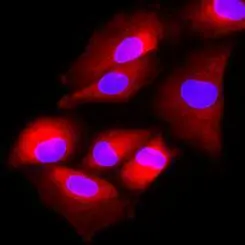
Cell lysates of NIH3T3(40ug) were resolved by SDS-PAGE, transferred to NC membrane and probed with anti-human FUS2 (1:500). Proteins were visualized using a goat anti-mouse secondary antibody conjugated to HRP and an ECL detection system.
FUS2 antibody [AT2F4]
GTX50012
ApplicationsImmunoFluorescence, Western Blot, ImmunoCytoChemistry
Product group Antibodies
ReactivityHuman, Mouse
Overview
- SupplierGeneTex
- Product NameFUS2 antibody [AT2F4]
- Delivery Days Customer9
- ApplicationsImmunoFluorescence, Western Blot, ImmunoCytoChemistry
- CertificationResearch Use Only
- ClonalityMonoclonal
- Clone IDAT2F4
- Concentration1 mg/ml
- ConjugateUnconjugated
- HostMouse
- IsotypeIgG1
- Scientific DescriptionVertebrate FUS2 genes, which are known to be putative tumor suppressor gene, contain several important domains such as the catalytic N-acetyltransferase (NAT) domain. NAT domain is essential enzymes involved in several sophisticated cellular processes such as N-acetylation, O-acetylatin. NAT enzymes may be involved in susceptibility to cancer including colorectal cancer because of the presence of carcinogenic heterocyclic amines in some cooked foods. FUS2 was physically localized to the cytoplasm. Also, FUS2 showed the actin dependent movement, closely related to the polarization in the budding yeast, Saccharomyces cerevisiae.
- ReactivityHuman, Mouse
- Storage Instruction-20°C or -80°C,2°C to 8°C
- UNSPSC12352203

